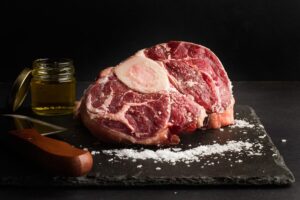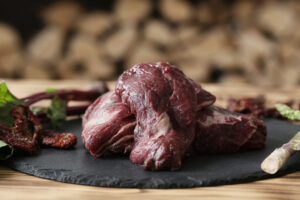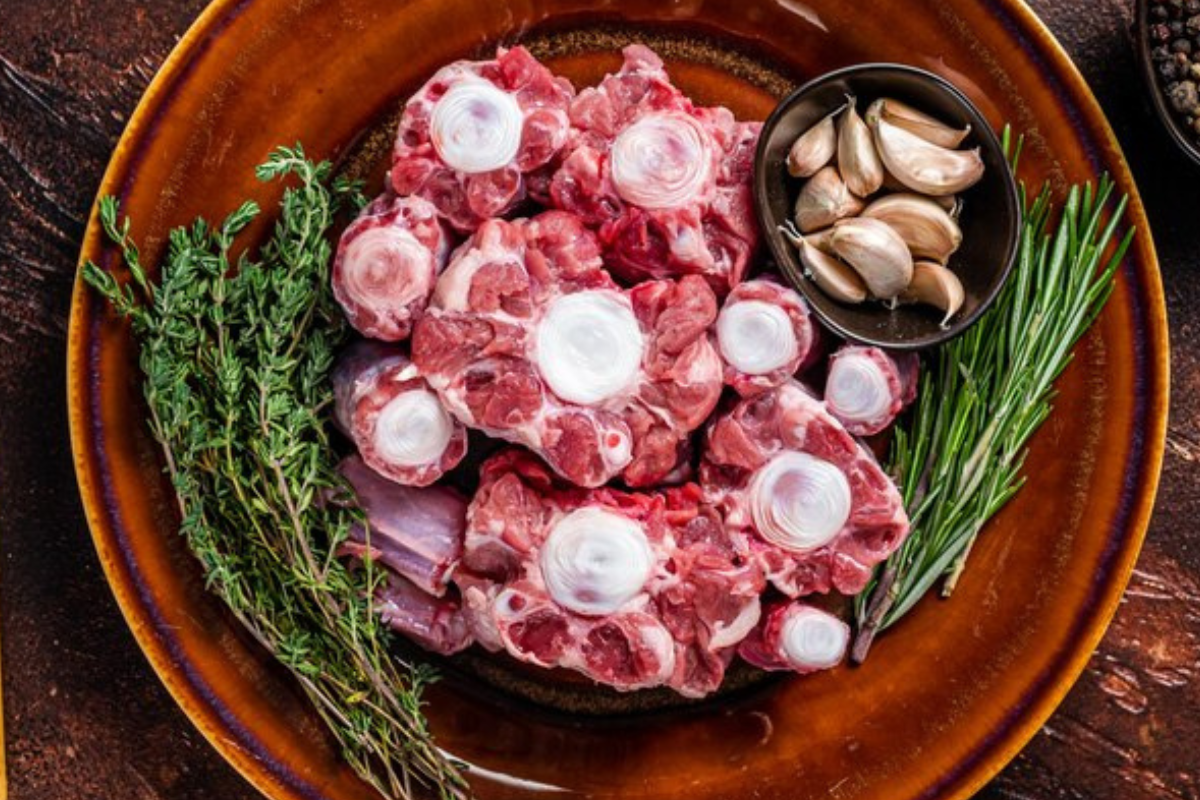Oxtail meat, once considered a humble ingredient, has evolved into a beloved delicacy in kitchens worldwide. This versatile cut, sourced from the tail of cattle, is packed with rich flavors and nutrients. As a result, many traditional and contemporary dishes now feature oxtail as a star ingredient. Whether you’re new to cooking with oxtail or looking to refine your skills, this guide provides everything you need to know. We cover its origins, cooking techniques, nutritional benefits, and role in various cuisines.
What is Oxtail?
Oxtail refers to the tail of cattle, traditionally from oxen but now commonly from cows. This cut contains high levels of gelatin, which gives it a deep, rich flavor. People once considered oxtail “peasant food” because it was a less desirable cut. However, as cooking methods advanced, oxtail gained popularity for its unique texture and taste. Today, many global cuisines embrace it as a favorite.
The History and Evolution of Oxtail
Historically, oxtail served as a staple in many diets due to its affordability. People ensured nothing went to waste by using every part of the animal. Over time, as culinary techniques developed, cooks began to appreciate oxtail’s potential. Consequently, the cut transitioned from humble kitchens to fine dining restaurants. Its rise in popularity demonstrates its versatility and the rich, comforting flavors it brings to dishes.
Explore how to use oxtail in a variety of recipes that highlight this cut’s potential.
Understanding the Anatomy of Oxtail

Oxtail consists of several vertebrae, each containing a central bone surrounded by meat, fat, and connective tissue. When you cut oxtail into sections, each piece includes a portion of bone. This bone adds a deep, beefy flavor to dishes during cooking. Furthermore, the high collagen content in the connective tissues makes oxtail ideal for slow-cooking. As a result, the meat becomes tender, and the gelatinous marrow enriches the dish’s texture.
Why Oxtail is Perfect for Slow Cooking
The structure of oxtail, with its combination of meat, fat, and bone, makes it perfect for slow-cooking methods. For instance, braising or stewing breaks down the collagen into gelatin. This process results in a silky, rich sauce that coats the meat. These transformations make oxtail a prized ingredient in recipes that require depth of flavor.
How to Prepare and Cook Oxtail
Cooking oxtail requires patience, but the results are worth the effort. Here’s a breakdown of how to prepare and cook oxtail to achieve the best results:
Preparation Steps
- Cleaning and Trimming: Start by rinsing the oxtail under cold water. This step removes any bone fragments and blood. Then, pat the pieces dry with a paper towel. Depending on your recipe, you might trim excess fat. However, keeping some fat is essential for flavor.
- Seasoning and Marinating: To enhance the oxtail’s flavor, season it generously. Use salt, pepper, and your favorite herbs and spices. Additionally, you can marinate the oxtail overnight. This allows the flavors to penetrate the meat deeply.
Popular Cooking Methods
- Braising: Braising is one of the most common methods for cooking oxtail. To braise, first, sear the oxtail in a hot pan until browned on all sides. Then, add liquid like broth, wine, or water and simmer the oxtail slowly for several hours. This method results in tender meat that falls off the bone and a rich, flavorful sauce.
- Slow-Cooking: Using a slow cooker is a convenient way to cook oxtail. Simply add the seasoned oxtail, vegetables, and liquids to the slow cooker. Then, cook on low heat for 6-8 hours. This method produces a dish full of deep, comforting flavors.
- Soups and Stews: Many traditional soups and stews feature oxtail as a key ingredient. Its gelatinous texture helps thicken the broth. Classic examples include Jamaican oxtail stew, Korean oxtail soup (Kkori Gomtang), and Italian oxtail stew (Coda alla Vaccinara).
For more tips on slow-cooking beef, consider reading this guide on cooking beef chuck roast. The techniques are similar and can apply to oxtail.
Exploring the Flavor Profile of Oxtail meat

Oxtail has a deep, beefy flavor that sets it apart from other cuts of meat. The combination of marrow, fat, and collagen contributes to its richness. Moreover, this flavor becomes more pronounced when you slow-cook it. As oxtail cooks, the marrow inside the bones melts. This process infuses the dish with an umami-packed taste that enhances the overall flavor.
Complementary Flavors
Oxtail pairs well with robust ingredients like garlic, onions, and tomatoes. Red wine is another excellent pairing. Additionally, these ingredients complement oxtail’s strong flavor. Herbs such as thyme, rosemary, and bay leaves also work well with oxtail’s richness. In Caribbean cuisine, cooks often use spices like allspice and Scotch bonnet peppers. These spices create a spicy, savory dish. In Korean cooking, the simplicity of garlic and onions allows oxtail’s flavor to shine.
Nutritional Benefits of Oxtail Meat
Oxtail is not only delicious but also packed with nutrients. Here’s a closer look at the nutritional benefits of oxtail:
Macronutrient Content
- Protein: Oxtail provides an excellent source of high-quality protein. Protein is essential for building and repairing muscle tissues. Consequently, a single serving of oxtail offers a substantial amount of protein. This nutrient makes it a satisfying and nourishing choice for meals.
- Fat: Oxtail contains more fat compared to leaner cuts of beef. This fat contributes to its rich flavor. However, you should enjoy oxtail in moderation, particularly if you’re watching your fat intake.
Micronutrient Content
- Iron: Oxtail contains a high level of iron, a mineral crucial for transporting oxygen throughout the body. Iron also supports overall energy levels.
- Zinc: This essential mineral is vital for immune function, wound healing, and DNA synthesis.
- Vitamin B12: Oxtail provides a good source of vitamin B12. This vitamin is important for nerve function, red blood cell formation, and DNA synthesis.
Collagen Content
One of oxtail’s standout features is its high collagen content. Collagen is a protein that provides structure to skin, hair, nails, and joints. When cooked, collagen breaks down into gelatin. Gelatin supports joint health, improves skin elasticity, and promotes gut health.
To learn more about incorporating nutrient-rich beef into your diet, check out this comprehensive guide to ground beef.
Where to Buy and How to Select Quality Oxtail meat
Finding high-quality oxtail can sometimes be a challenge. However, here are some tips on where to buy it and what to look for:
Where to Buy Oxtail meat
- Butcher Shops: Your local butcher often provides the best source of fresh oxtail. Butchers can also offer advice on the best ways to cook it. In some cases, butchers might even cut it to your specifications.
- Grocery Stores: Many grocery stores, particularly those with a well-stocked meat section, carry oxtail. Look for oxtail in the frozen meat section if you don’t see it in the fresh meat aisle.
- Online Retailers: If you struggle to find oxtail locally, several online retailers specialize in high-quality, sustainably sourced meat products. This option can be convenient if you’re looking for specific cuts or need a larger quantity.
What to Look For
When selecting oxtail, choose pieces with a good amount of meat. Freshness is indicated by a bright color. Additionally, look for well-marbled pieces with fat, as marbling contributes to the flavor and tenderness of the meat.
Oxtail in Global Cuisines
Oxtail is a versatile ingredient that features prominently in many global cuisines. Each culture has its unique way of preparing and enjoying this flavorful cut of meat:
African Cuisine
In African cuisine, cooks often use oxtail in hearty stews. They slow-cook it with indigenous spices and serve it with staple foods like yams, rice, or couscous. The rich, gelatinous meat adds depth and flavor to these dishes, resulting in comforting and satisfying meals.
Caribbean Cuisine
Caribbean oxtail dishes are known for their bold flavors. Cooks often use allspice, thyme, and Scotch bonnet peppers in these dishes. For example, Jamaican oxtail stew is a popular dish where the oxtail is slow-cooked with beans and vegetables, creating a spicy, savory meal. This dish is typically served with rice and peas.
European Cuisine
In European cuisine, particularly Italian, oxtail is used in dishes like Coda alla Vaccinara. This Roman stew involves slow-cooking oxtail with tomatoes, red wine, and vegetables. As a result, the dish showcases oxtail’s ability to bring depth of flavor to a meal.
Asian Cuisine
In Korea, oxtail is used to make Kkori Gomtang. This clear, nourishing soup is traditionally eaten during the colder months. The simple ingredients—oxtail, garlic, onions, and water—allow the rich flavor of oxtail to be the star. The long simmering time extracts all the goodness from the bones, creating a flavorful and nutritious broth.
For more inspiration on cooking different beef cuts, you might also enjoy this guide on sirloin tip steak.
Sustainability and Ethical Considerations of Oxtail meat
As with all meat products, considering the sustainability and ethical sourcing of oxtail is important. Oxtail often serves as a byproduct of beef production. Therefore, it is a more sustainable choice compared to prime cuts like steak. However, to ensure your oxtail comes from ethically raised cattle, look for labels indicating the meat is grass-fed, hormone-free, and sourced from farms practicing sustainable agriculture.
Supporting local farmers who prioritize animal welfare and environmental sustainability can make a significant difference. When possible, buy oxtail from farmers’ markets or directly from farms you trust.
FAQs.
Here are some frequently asked questions about oxtail meat:
- What part of the cow is oxtail?
Oxtail comes from the tail of cattle. It is typically cut into sections, each with a bone center surrounded by meat, fat, and cartilage. - Is oxtail considered healthy?
Yes, oxtail is nutrient-dense, providing a good source of protein, collagen, and essential vitamins and minerals. However, it is also high in fat, so consume it in moderation. - How long does it take to cook oxtail?
Oxtail requires slow cooking for several hours, typically 4-6 hours, depending on the method. This ensures that the meat becomes tender and the flavors develop fully. - Can you cook oxtail in a pressure cooker?
Yes, a pressure cooker can significantly reduce the cooking time for oxtail, often down to just 1-2 hours.
Common Myths About Oxtail Meat
There are several misconceptions about oxtail meat:
- Myth 1: Oxtail is only from oxen.
While people historically sourced oxtail from oxen, it now typically comes from cows and steers. - Myth 2: Oxtail is tough and hard to cook.
With the right cooking method, such as slow-cooking or braising, oxtail becomes incredibly tender. - Myth 3: Oxtail is unhealthy.
Though high in fat, oxtail is rich in nutrients like collagen and iron. This makes it a beneficial part of a balanced diet when consumed in moderation.
Final Thoughts on Oxtail Meat
Oxtail is a delicious and versatile cut of meat that has been cherished in cuisines around the world for centuries. Its rich flavor and nutrient profile make it a worthy addition to any kitchen. Whether you slow-cook it in a stew or braise it for hours, the effort is well worth the reward. If you haven’t tried cooking with oxtail yet, now is the perfect time to explore this culinary gem.
For additional recipe ideas and tips on cooking with beef, you might also be interested in how to make the perfect sourdough French toast or why sirloin tip steak is a great choice.

